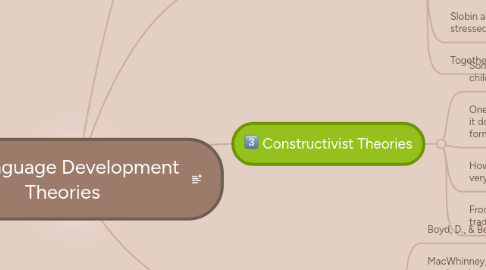Language Development Theories
by Kendell Clark

1. Environmental Theories
1.1. Based on learning theory or on the idea that children learn language by imitation.
1.2. Skinner argued that in addition to the role they play in imitation, parents shape language through systematic reinforcements, gradually rewarding better and better approximations of adult speech (the process of shaping) (Bee & Boyd, 2012, p.202)
1.3. It seems obvious that what is said to a child has to play some role in the process of language formation (Bee & Boyd, 2012, p.202)
1.4. Children who are exposed to less (and less varied) language in their earliest years don’t seem to catch up later in vocabulary (MacWhinney, 2011)
2. Nativist Theories
2.1. Most of what is required for learning language is inherently designed into humans.
2.2. Early nativist theorists such as Noam Chomsky (1965, 1975, 1986, 1988) were especially struck by two phenomena: the extreme complexity of the task the child must accomplish, and the apparent similarities in the steps and stages of children’s early language development across languages and among all children (Bee & Boyd, 2012, p.204)
2.3. Slobin argues that just as the newborn infant seems to come programmed with “rules to look by,” infants and children are programmed with “rules to listen by.” (Bee & Boyd, 2012, p.204)
2.4. Slobin also proposes that babies are preprogrammed to pay attention to the beginnings and endings of strings of sounds and to stressed sounds—a hypothesis supported by research (e.g., Yu & Ballard, 2007)
2.5. Together, these operating principles help to explain some of the features of children’s early grammar. (Bee & Boyd, 2012, p.204)
3. Constructivist Theories
3.1. Some theorists argue persuasively that what is important is not the built-in biases or operating principles but the child’s construction of language as part of the broader process of cognitive development (Akhtar, 2004)
3.2. One prominent proponent of this view, Melissa Bowerman, puts the proposition this way: “When language starts to come in, it does not introduce new meanings to the child. Rather, it is used to express only those meanings the child has already formulated independently of language” (1985, p. 372)
3.3. However, Bowerman (2007), also notes that as the child starts to use language to express the ideas he is beginning to grasp, the very act of creating linguistic frameworks for them helps him better understand them. (Bee & Boyd, 2012, p.204)
3.4. From the constructivist perspective, cognitive and language development are interdependent processes, and research in the constructivist tradition looks for linkages between advances in the two domains. (Bee & Boyd, 2012, p.205)
4. References:
4.1. Boyd, D., & Bee, H. (2013). The Developing Child (13th ed.). Retrieved from The University of phoenix eBook Collection database.
4.2. MacWhinney, B. (2011). Language development. In M. Bornstein & M. Lamb (Eds.), Developmental science: An advanced textbook (page numbers in press). New York: Psychology Press.
4.3. Yu, C., & Ballard, D. (2007). A unified model of early word learning: Integrating statistical and social cues. Neurocomputing: An International Journal, 70, 2149–2165.
4.4. Akhtar, N. (2004). Nativist versus constructivist goals in studying child language. Journal of Child Language, 31, 459–462.
4.5. Bowerman, M. (1985). Beyond communicative adequacy: From piecemeal knowledge to an integrated system in the child’s acquisition of language. In K. E. Nelson (Ed.), Children’s language (Vol. 5, pp. 369–398). Hillsdale, NJ: Erlbaum.


